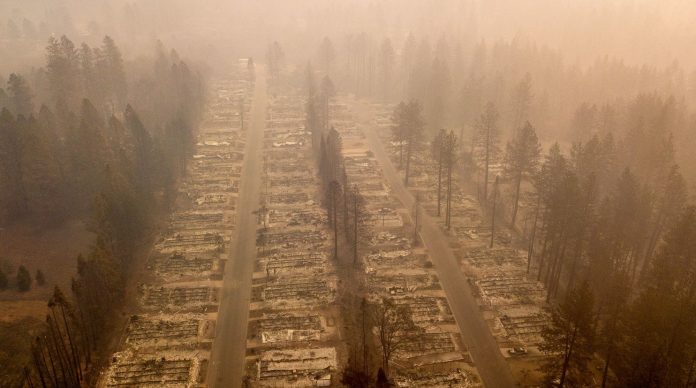Not so long ago, California wildfires knew their place. They burned wilderness areas, national forests and remote, sparsely inhabited canyons far from population centers. Sometimes cabins would burn, even homes when sparks flew and landed on the wooden shake roofs that were still allowed back in those days.
Now our wildfires know no bounds.
Unlike hurricanes that are christened in alphabetical order, and decided upon in advance, fires are named for the places where they start — the Woolsey Fire and the Camp Fire, most recently — and are much closer to homes than ever before. Their flames sweep through natural spaces and leap from exurb to suburb and burst into neighborhoods, taking lives and incinerating homes. They burn with a ferocity and randomness that is horrifying for those in the fire’s path and gut-wrenching for the millions watching them broadcast in real time.
Friends and family end up on television, struggling to express their losses as well as their gratitude to first-responders, though they have lost everything but the clothes on their backs.
This year, the loss of lives and the destruction of the built environment are unprecedented. So, too, is the loss of the natural world, the place where I have spent so much time and, as a nature writer and chronicler of hiking trails, shared nature with as many people as I can. Nature has something to tell us. It’s time we listened.
Nature is my neighborhood. My communities are the coastal sage, the chaparral and the oak woodlands. I know the mountains, creeks and canyons by name.
Last year, as the Thomas Fire swept across the mountains behind my hometown of Santa Barbara, I saw one canyon after another devastated: Franklin Canyon, Romero Canyon, San Ysidro Canyon, Hot Springs Canyon, Cold Spring Canyon. Ash fell like snow from the sky; smoke penetrated our Red Cross-issued N95 masks. From my kitchen window, six blocks from downtown, I watched displaced, distressed wildlife. A wobbly-legged deer zigzagged down our street. A red-tailed hawk circled aimlessly for hours over our old bungalow.
Before fires ravaged these places, I celebrated their beauties: waterfalls, wildflowers and the sweet scent of the scrubby chaparral. After the fire was out, I returned to hike the blackened land to observe what was burned, what was spared and determine whether the trails were safe for my readers to travel.
This week’s fires burned more of the land I’ve come to know and love, blazing across Boney Peak, Malibu Creek and Arroyo Sequit. I watched these places burn on national TV. The nameless “brush” in the reporting of brush fires is actually a complex of drought-resistant beauties that include ceanothus, California buckwheat, manzanita, lemonade berry and hummingbird sage.
The chaparral is habitat for a multitude of creatures. What the videos of the fires in the Santa Monica Mountains (partly under the stewardship of the National Park Service) don’t show is the likely grim fate of the coyotes, rabbits and deer fleeing the flames. And the birds — the wrentit, the scrub jay, the sage sparrow — taking flight to . . . where exactly? And what about the California quail, the state bird, running for cover at a pace slower than that of the advancing fire?
Yes, fire is a natural part of this biome, but not at this scale, not in such frequency, and not in places where native species already struggle against so much encroachment. My forays into the natural world once began at remote trailheads, but now too often begin at parking lots and gateways at the ends of cul-de-sacs. The built world and the natural world are more closely intertwinedthan ever before. It is not just the isolated mansion that has been built at the edge of the city; whole communities have cropped up in what was once nature’s domain. What we used to call the “urban-rural interface” is now a fuzzy border. Nature may be easier to reach, but city life is harder to leave behind.
California’s chaparral has evolved to survive, even thrive, with fire. Humans have not. It is becoming increasingly apparent that nearly every resident in the state now lives in a fire zone. Climate change has altered fire behavior and, in response, we must consider altering our own behaviors. Certainly there should be serious reflection on the romantic notion of living in peaceful harmony next door to nature — without knowing much about it or believing it can be controlled to our liking.
We properly focus first and foremost on the human toll in this season of loss, but hard questions about how and where we live lie on our horizon. After the fires are extinguished, as our grieving hearts and the scorched land begin to heal, it will be time to reconnect with nature in a new way with appreciation for its wonders and respect for its immense power.
By
John McKinney is the author of 30 books about hiking, including “Hiking on the Edge: Dreams, Schemes, and 1600 Miles on the California Coastal Trail.”
































